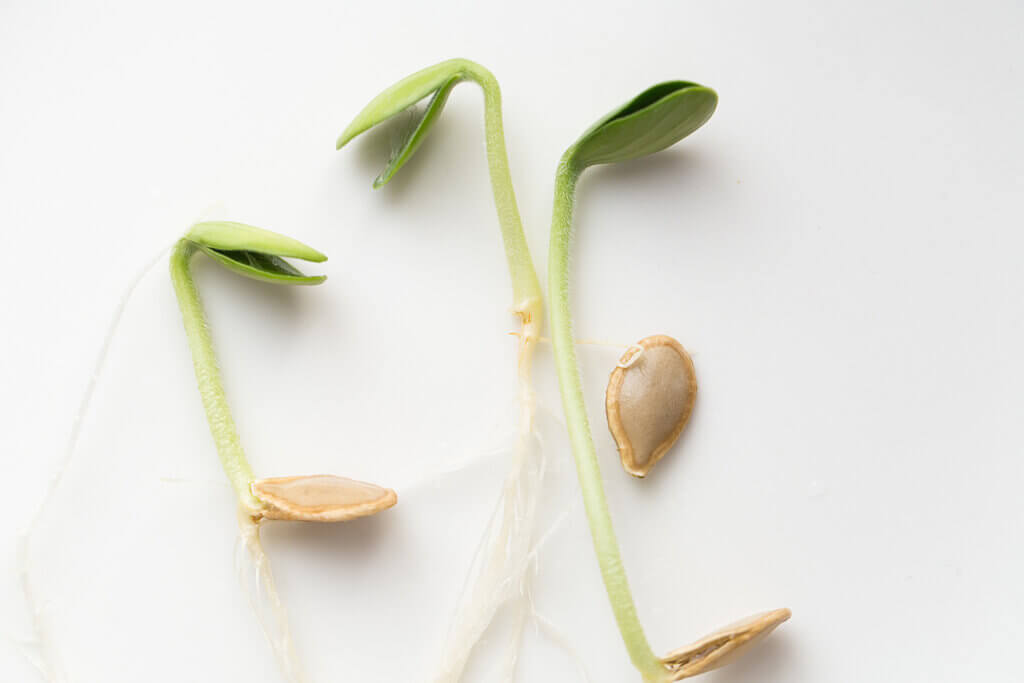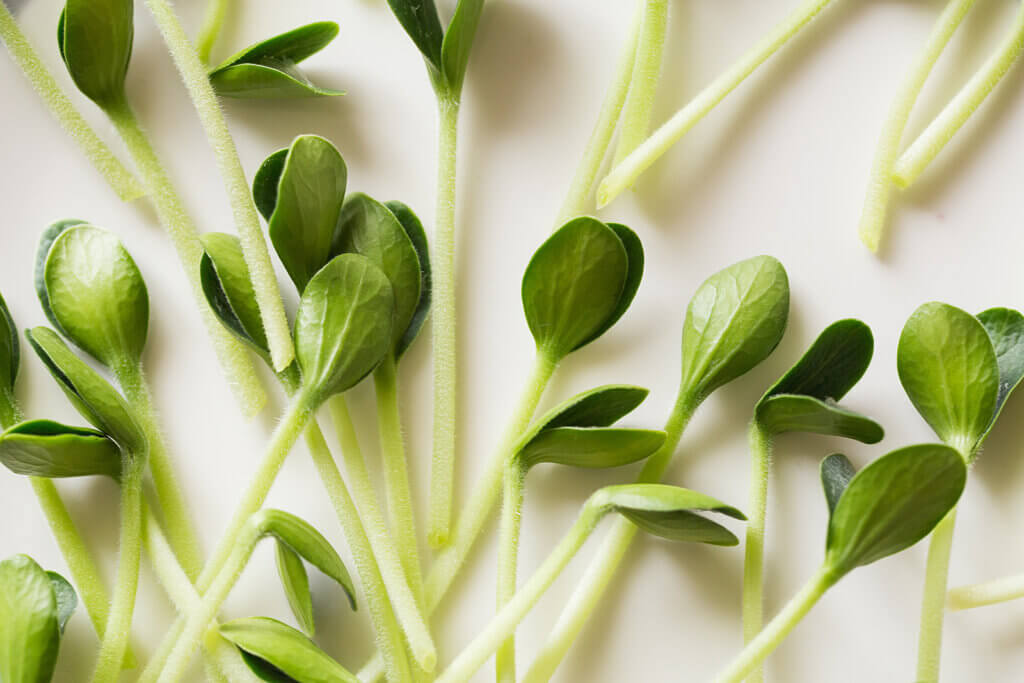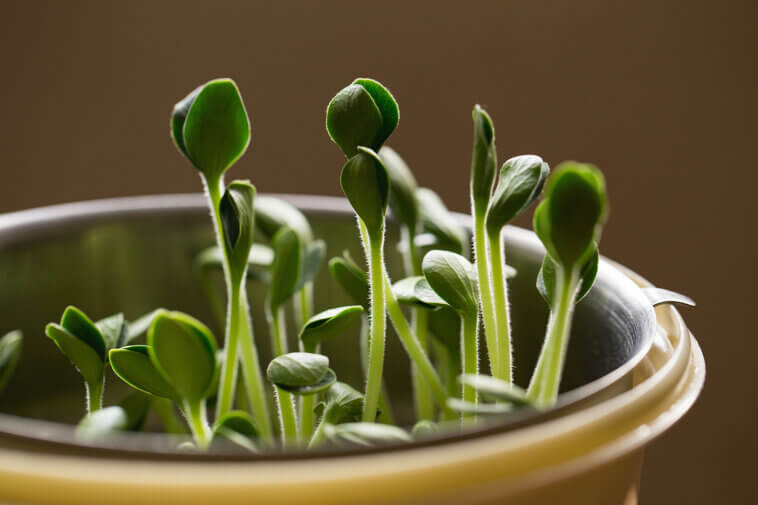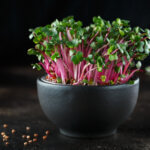Table of Contents
Introduction to Pumpkin Microgreens
When I think of pumpkins, I can't help but picture vibrant jack-o'-lanterns, delicious pumpkin pies, and the warm, cozy feeling of autumn decor. However, I recently discovered an exciting addition to the pumpkin family that has captured my attention: pumpkin microgreens. These tiny greens are a nutritional powerhouse that I believe deserves a permanent place at my table, no matter the season.
In this in-depth guide, I'm excited to share my journey into the world of pumpkin microgreens, where I'll delve into their cultivation, uncover their incredible health benefits, explore their culinary potential, and more. Join me as we embark on this delightful culinary adventure with pumpkin microgreens!
What Are Pumpkin Microgreens?
Pumpkin microgreens, scientifically referred to as Cucurbita pepo var. ovifera sprouts, represent the nascent growth stage of pumpkin plants. These delicate and diminutive greens are cultivated and harvested within a short span of just a few weeks from the moment the pumpkin seeds germinate, usually when they attain a height ranging from 1 to 2 inches.
Despite their relatively lesser recognition compared to popular microgreens such as spinach or broccoli, pumpkin microgreens possess a distinctive set of attributes and advantages that make them an intriguing choice for both culinary and nutritional purposes. These attributes include their unique flavor profile, nutrient density, and versatility in various dishes.

Cultivating Pumpkin Microgreens
Embarking on the journey of cultivating pumpkin microgreens can be both rewarding and educational. These miniature greens pack a punch of flavor and nutrition, making them a fantastic addition to your culinary repertoire. To ensure a thriving crop, let's dive deeper into the process with an extended guide:
Choosing the Right Seeds
The cornerstone of your microgreen endeavor is selecting the finest pumpkin seeds. Look for reputable suppliers offering organic, non-GMO seeds. While various pumpkin varieties can be used, the Sugar Pie Pumpkin (Cucurbita pepo) is often favored for its exceptional taste and robust growth potential.
Germination and Growing Medium
Pumpkin microgreens thrive in a well-draining and sterile growing medium. You have several options, including traditional potting soil, sustainable coconut coir, or innovative hydroponic setups. Maintain the medium's moisture at an optimal level, ensuring it's consistently damp but never waterlogged.
Sowing and Germination
When sowing your pumpkin seeds, consider planting them densely across your chosen growing medium. Cover them with a thin layer of soil or growing medium and mist them lightly. Place the trays or containers in a warm, well-lit location, preferably near a sunlit window or under dedicated grow lights. Typically, pumpkin seeds germinate within 5-7 days, revealing the emergence of tiny sprouts.
Light and Temperature
Pumpkin microgreens require specific light and temperature conditions for successful growth. Providing them with 12-16 hours of light each day is essential. You can achieve this through natural sunlight or by using specialized grow lights. To maintain the optimal temperature range of 70-75°F (21-24°C), consider using a heat mat or ensuring a consistently warm environment.
Watering and Care
A consistent watering routine is critical for the well-being of your pumpkin microgreens. Strive to keep the soil or growing medium evenly moist, but take care not to overwater, as excessive moisture can lead to mold and root rot. Adequate air circulation is equally important to prevent fungal issues, so ensure there is some airflow around your growing trays or containers.
Harvesting and Enjoying
After a few weeks of attentive care, your pumpkin microgreens will reach a height of 1 to 2 inches. At this stage, they are ready for harvest. Use clean scissors or shears to cut the microgreens just above the soil line. These tender greens can be used to elevate a variety of dishes, adding a delightful burst of flavor and a nutritional boost to salads, sandwiches, smoothies, and more.
See also our post on Dun Pea Microgreens
Nutritional Benefits of Pumpkin Microgreens
Delving deeper into the world of pumpkin microgreens unveils a treasure trove of nutritional benefits that can significantly enhance your diet and overall well-being. Here's an in-depth look at the myriad advantages these miniature greens offer:
Rich in Vitamins and Minerals
Pumpkin microgreens are a nutritional powerhouse, brimming with essential vitamins and minerals that are vital for maintaining good health. They are particularly abundant in vitamins A, C, and K, each playing a unique role in supporting various bodily functions. Vitamin A promotes healthy skin and vision, while vitamin C bolsters the immune system and aids in collagen production. Meanwhile, vitamin K contributes to blood clotting and bone health. Additionally, these microgreens provide valuable minerals such as potassium and calcium, which are crucial for heart health and maintaining strong bones.
Antioxidant Powerhouse
Beyond their vitamin and mineral content, pumpkin microgreens are a potent source of antioxidants. These compounds play a pivotal role in protecting the body from oxidative stress by neutralizing harmful free radicals. The high concentration of beta-carotene, a type of antioxidant found in pumpkin microgreens, not only contributes to their vibrant color but also promotes healthy skin, supports vision, and reduces the risk of chronic diseases.
Fiber and Digestive Health
Incorporating pumpkin microgreens into your diet can be a boon for your digestive system. These microgreens are rich in dietary fiber, which is essential for maintaining regular bowel movements and promoting a feeling of fullness. The fiber content also contributes to stabilizing blood sugar levels, making them a valuable addition for those managing their glucose levels.
Immune System Support
As a natural reservoir of essential vitamins and minerals, pumpkin microgreens play a pivotal role in supporting a robust immune system. Their nutritional profile provides the body with the necessary tools to fend off infections and illnesses, making them an ideal choice for bolstering your immunity, particularly during cold and flu seasons.
Culinary Uses for Pumpkin Microgreens
Pumpkin microgreens, with their delicate flavor and impressive nutritional profile, offer a world of culinary possibilities. Here's an expanded look at how you can incorporate these tiny greens into your meals to elevate both taste and nutrition:
- Salads: Pumpkin microgreens shine as a refreshing addition to salads. Their earthy, mildly sweet flavor complements other greens like spinach, arugula, or kale. Their tender texture provides a pleasant crunch, enhancing the overall salad experience. Consider mixing them with various vegetables, nuts, and dressings for a balanced and nutritious salad.
- Sandwiches and Wraps: Elevate your sandwiches and wraps by including a generous handful of pumpkin microgreens. Whether your filling is vegetarian or meat-based, these microgreens provide a satisfying crunch and a burst of nutrients. They not only add visual appeal but also contribute a unique flavor dimension to your handheld delights.
- Smoothies: Transform your morning smoothie into a nutritional powerhouse by incorporating pumpkin microgreens. Their mild taste won't overpower the other ingredients, making them a stealthy addition that packs a punch in terms of vitamins, minerals, and antioxidants. Blend them with fruits, yogurt, and your choice of liquids for a vibrant and healthful concoction.
- Soups and Stews: Take your soups and stews to the next level by using pumpkin microgreens as a garnish. Sprinkle a handful atop your favorite hearty dishes to introduce a fresh element and a pop of color. Beyond aesthetics, these microgreens infuse your culinary creations with added nutrients and a delightful texture contrast.
- Omelets and Scrambles: Don't limit pumpkin microgreens to just lunch and dinner; they also make a splendid addition to breakfast dishes. Stir them into omelets or scrambled eggs for a nutrient-packed and visually appealing morning meal.
- Pizzas and Flatbreads: When it comes to pizzas and flatbreads, consider sprinkling pumpkin microgreens over the top before baking. They'll add a burst of freshness and a unique flavor twist that pairs wonderfully with various toppings and sauces.
- Sushi Rolls: For a creative twist on sushi, incorporate pumpkin microgreens into your rolls. Their vibrant color and subtle flavor can enhance both the taste and presentation of your homemade sushi creations.

Harvesting and Storage
When it comes to harvesting pumpkin microgreens, the process is relatively simple, but a few key considerations can help you maximize their freshness and nutritional value. Here's a detailed guide on harvesting and proper storage:
Harvesting
To harvest your pumpkin microgreens, you'll need a pair of scissors or a sharp knife. The optimal time to harvest is when these tiny greens reach a height of approximately 1 to 2 inches. Carefully cut them just above the soil line, ensuring a clean and even cut. Harvesting at this stage guarantees the best balance of flavor and tenderness.
Timing is Key
It's advisable to harvest your pumpkin microgreens just before you plan to use them in your culinary creations. This approach ensures maximum freshness and retains the peak of their nutrient content. Microgreens are at their prime right after cutting, so incorporating them immediately into your dishes allows you to savor their vibrant flavors and nutritional benefits.
Storage
For any leftover pumpkin microgreens, proper storage is essential to maintain their quality. Place them in an airtight container or resealable plastic bag to prevent moisture loss and exposure to air, which can lead to wilting and loss of freshness. Refrigeration is the best method for preserving pumpkin microgreens, as it helps prolong their shelf life. When stored in the refrigerator, these microgreens can remain fresh for up to a week.
Minimize Moisture
It's crucial to avoid excess moisture when storing pumpkin microgreens. To achieve this, you can line the container or bag with a paper towel to help absorb any excess moisture, which can lead to rot or mold growth. Check the container periodically and remove any wilting or discolored microgreens to ensure that the remaining ones stay in optimal condition.
By following these harvesting and storage guidelines, you can make the most of your homegrown or store-bought pumpkin microgreens. Enjoy the convenience of having these nutritious greens readily available for various culinary creations, whether it's adding a vibrant touch to salads, enhancing the flavor of sandwiches, or boosting the nutrient content of your favorite dishes.
Tips for Incorporating Pumpkin Microgreens into Your Diet
Now that you know about the impressive health benefits of pumpkin microgreens, let's explore some creative ways to incorporate them into your daily meals:
Morning Smoothie Booster
Add a handful of pumpkin microgreens to your morning smoothie. Their mild flavor won't overpower the taste of your favorite fruits, but you'll benefit from the added nutrients and fiber.
Satisfying Salad Base
Use pumpkin microgreens as the base for your salads. Their tender texture and earthy flavor pair well with a wide range of toppings, from roasted vegetables to grilled chicken or tofu.
Garnish for Soups and Risottos
Elevate your homemade soups and creamy risottos by garnishing them with a handful of freshly harvested pumpkin microgreens just before serving. This adds a burst of color, freshness, and a subtle peppery note.
Nutrient-Rich Sandwiches
Upgrade your sandwiches and wraps by layering them with pumpkin microgreens. They provide a delightful crunch and a burst of vitamins and minerals, making your meal both tasty and nutritious.
9.5 Pizza Topping
For a unique twist on pizza, scatter pumpkin microgreens over your favorite pizza just before it goes into the oven. They'll wilt slightly and add a fresh, herbaceous note to your slice.
See also our post on Daikon Microgreens
Frequently Asked Questions (FAQs) About Pumpkin Microgreens
Q1: Are pumpkin microgreens the same as pumpkin sprouts?
A1: Pumpkin microgreens and pumpkin sprouts both refer to young pumpkin plants, but there is a subtle distinction. Pumpkin microgreens are typically harvested when they reach a height of 1 to 2 inches. In contrast, pumpkin sprouts are usually collected at an earlier stage when they first emerge from the soil, showcasing even more tender and nascent growth.
Q2: Can I grow pumpkin microgreens indoors all year round?
A2: Indeed, you can cultivate pumpkin microgreens indoors throughout the entire year, irrespective of the prevailing season. The key is to ensure they receive adequate light, especially if natural sunlight is limited. Supplementary grow lights can be a valuable resource for maintaining optimal growth conditions indoors.
Q3: Do pumpkin microgreens taste like mature pumpkins?
A3: Pumpkin microgreens possess a flavor distinct from that of mature pumpkins. Their taste is milder, offering a fresh, earthy essence with subtle nutty undertones. Unlike mature pumpkins, their flavor is not characterized by the intense sweetness commonly associated with fully grown pumpkin varieties.
Q4: Are there any specific pests or diseases I should watch out for when growing pumpkin microgreens?
A4: While pumpkin microgreens are relatively resilient to pests and diseases, vigilance is prudent. Keep an eye out for common garden pests such as aphids and spider mites, which may occasionally appear. To mitigate disease risks, maintain proper air circulation, and exercise caution against overwatering.
Q5: Can I freeze pumpkin microgreens for long-term storage?
A5: Freezing pumpkin microgreens is generally discouraged, as it can compromise their texture and flavor. It's best to savor them fresh or store any surplus in the refrigerator for up to a week in an airtight container to maintain their quality.
Q6: Are there any safety concerns when consuming pumpkin microgreens?
A6: Pumpkin microgreens are typically safe to consume, but, as with all produce, they should be washed thoroughly before consumption to remove any potential contaminants. Individuals with known allergies or sensitivities to pumpkin or related foods should seek advice from a healthcare professional before incorporating them into their diet.
Q7: Can I use any type of pumpkin seeds for growing pumpkin microgreens?
A7: While you can experiment with different types of pumpkin seeds, it's advisable to opt for seeds explicitly labeled for microgreen production. These seeds are often chosen for their rapid germination and the abundance of tender shoots they yield, ensuring a successful microgreen harvest.
Q8: Can pumpkin microgreens be grown hydroponically?
A8: Yes, pumpkin microgreens can indeed be cultivated hydroponically. Hydroponic systems offer an excellent environment for their growth, allowing for precise control over nutrient levels and water distribution. Ensure that your chosen hydroponic setup is suitable for the specific requirements of growing microgreens.
Q9: Are there any unique culinary pairings that work particularly well with pumpkin microgreens?
A9: Pumpkin microgreens' versatility extends to various culinary pairings. They harmonize beautifully with ingredients such as goat cheese, cranberries, toasted nuts, and balsamic vinaigrette when used in salads. Their mild flavor also complements dishes with delicate flavors, such as risottos and creamy soups.
Q10: Can I use pumpkin microgreens in cooked dishes, or are they best enjoyed raw?
A10: Pumpkin microgreens are highly versatile and can be employed in both raw and cooked dishes. When used raw, they contribute a fresh, crisp texture to salads and sandwiches. Conversely, they can also be lightly sautéed or employed as a garnish in cooked dishes like pasta, omelets, and stir-fries, enhancing their flavor and nutritional content.
Conclusion
In conclusion, my journey with pumpkin microgreens has been a delightful and enriching experience. These tiny greens, often overlooked, have earned a permanent spot at my table throughout the year. Cultivating them from seed to vibrant microgreens has been a rewarding journey, and their remarkable nutritional benefits have left me amazed.
From elevating the flavor and nutrition of my dishes to the joy of harvesting and storing them for culinary adventures, pumpkin microgreens have become an integral part of my culinary repertoire.
They've not only added a fresh dimension to my meals but also deepened my appreciation for the wonders of nature and the boundless possibilities that can emerge from our own gardens. My personal connection with pumpkin microgreens continues to flourish, reminding me that the simplest ingredients can often be the most transformative.




Comments
Loading…